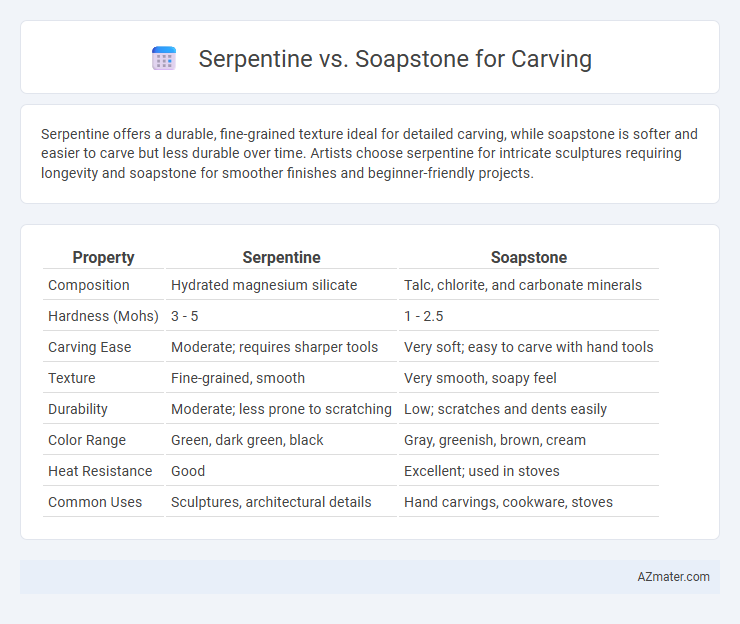Serpentine offers a durable, fine-grained texture ideal for detailed carving, while soapstone is softer and easier to carve but less durable over time. Artists choose serpentine for intricate sculptures requiring longevity and soapstone for smoother finishes and beginner-friendly projects.
Table of Comparison
| Property | Serpentine | Soapstone |
|---|---|---|
| Composition | Hydrated magnesium silicate | Talc, chlorite, and carbonate minerals |
| Hardness (Mohs) | 3 - 5 | 1 - 2.5 |
| Carving Ease | Moderate; requires sharper tools | Very soft; easy to carve with hand tools |
| Texture | Fine-grained, smooth | Very smooth, soapy feel |
| Durability | Moderate; less prone to scratching | Low; scratches and dents easily |
| Color Range | Green, dark green, black | Gray, greenish, brown, cream |
| Heat Resistance | Good | Excellent; used in stoves |
| Common Uses | Sculptures, architectural details | Hand carvings, cookware, stoves |
Overview: Serpentine vs Soapstone for Carving
Serpentine and soapstone are both popular carving materials prized for their softness and workability, but they differ significantly in composition and finish. Serpentine is a harder, more durable stone with a smooth, waxy texture and vibrant green hues, making it ideal for detailed, polished sculptures. Soapstone, composed primarily of talc, offers a softer, soapy feel and is favored for its ease of carving and ability to hold fine, intricate details despite being less durable than serpentine.
Geological Origins and Composition
Serpentine, primarily formed through the hydration and metamorphic transformation of ultramafic rocks, contains magnesium silicate minerals giving it a distinct greenish hue and smooth texture ideal for intricate carving. Soapstone is largely composed of talc, dolomite, and chlorite, originating from metamorphosed magnesium-rich limestone, resulting in a softer, soapy feel that carvers favor for its ease of shaping. The geological composition of serpentine offers a harder material compared to the softer, more workable nature of soapstone, influencing their application in detailed sculpting and tools.
Physical Properties Comparison
Serpentine features a softer composition with a Mohs hardness of 2.5 to 5, making it easier to carve but less durable than soapstone. Soapstone has a consistent hardness of 1 to 2.5 on the Mohs scale, known for its smooth, soapy texture that allows for fine detail work and excellent heat resistance. Both stones are dense and non-porous, but soapstone's higher talc content contributes to its greater softness and workability for intricate carving projects.
Ease of Carving: Workability Differences
Serpentine offers moderate ease of carving due to its slightly softer and more granular texture, making it suitable for beginners and detailed work. Soapstone, being much softer and smoother, provides superior workability for intricate carving and fine detailing, preferred by artisans seeking effortless shaping. The lower hardness of soapstone greatly reduces tool wear, enhancing carving speed and precision compared to serpentine.
Color and Aesthetic Characteristics
Serpentine offers a vibrant range of colors, including deep greens, yellows, and browns, with smooth, often glossy surfaces that enhance detailed carving and intricate designs. Soapstone features muted, earthy tones like soft grays, greens, and creamy whites, prized for its smooth texture and subtle, natural veining that lends each piece a unique, rustic appeal. Both stones vary in hardness, but Serpentine's bold color palette provides a striking, polished finish, while Soapstone's matte, tactile quality promotes a warm, organic aesthetic ideal for traditional or contemporary sculptures.
Durability and Finished Product Longevity
Serpentine offers moderate durability with a softer texture, making it easier to carve but more prone to wear and chipping over time. Soapstone provides superior durability due to its dense, talc-rich composition, resulting in carvings that resist scratches and weathering for extended longevity. Finished soapstone products maintain their integrity and smooth appearance longer, ideal for detailed sculptures and functional items.
Availability and Cost Factors
Serpentine is more widely available and generally less expensive than soapstone, making it a popular choice for carving beginners and artisans on a budget. Soapstone, known for its smooth texture and durability, tends to be pricier due to its limited geographical availability and higher demand in artistic markets. The cost difference also reflects the ease of carving, with serpentine offering softer material that reduces tool wear and labor time.
Health and Safety Considerations
Serpentine and soapstone differ significantly in health and safety considerations during carving; serpentine may contain trace amounts of asbestos fibers, posing respiratory hazards if proper protective equipment such as masks and ventilation are not used. Soapstone, being primarily composed of talc and magnesium carbonate, generally produces less harmful dust, but long-term inhalation can still lead to respiratory issues, necessitating dust control measures. Both stones require adequate safety practices, including wet carving techniques and respiratory protection, to minimize health risks.
Best Uses: Project Suitability
Serpentine is ideal for intricate and detailed carving projects due to its fine grain and relatively soft texture, making it perfect for small sculptures and jewelry pieces. Soapstone, being softer and easier to carve, is best suited for beginners and larger projects such as household items, kitchenware, and architectural elements where smooth finishes are desired. Choosing between serpentine and soapstone depends on project scale, detail requirements, and the carver's skill level.
Final Verdict: Choosing Between Serpentine and Soapstone
Serpentine offers a harder, more durable surface ideal for detailed carving and final pieces requiring longevity, while soapstone features a softer texture that is easier to shape, making it perfect for beginners and intricate, smooth finishes. The choice depends on the carver's skill level and project needs, with serpentine suited for experienced artisans seeking resilience, and soapstone favored for its workability and affordability. For long-lasting, finely detailed sculptures, serpentine is preferred; for easier manipulation and softer designs, soapstone remains the optimal choice.

Infographic: Serpentine vs Soapstone for Carving
 azmater.com
azmater.com